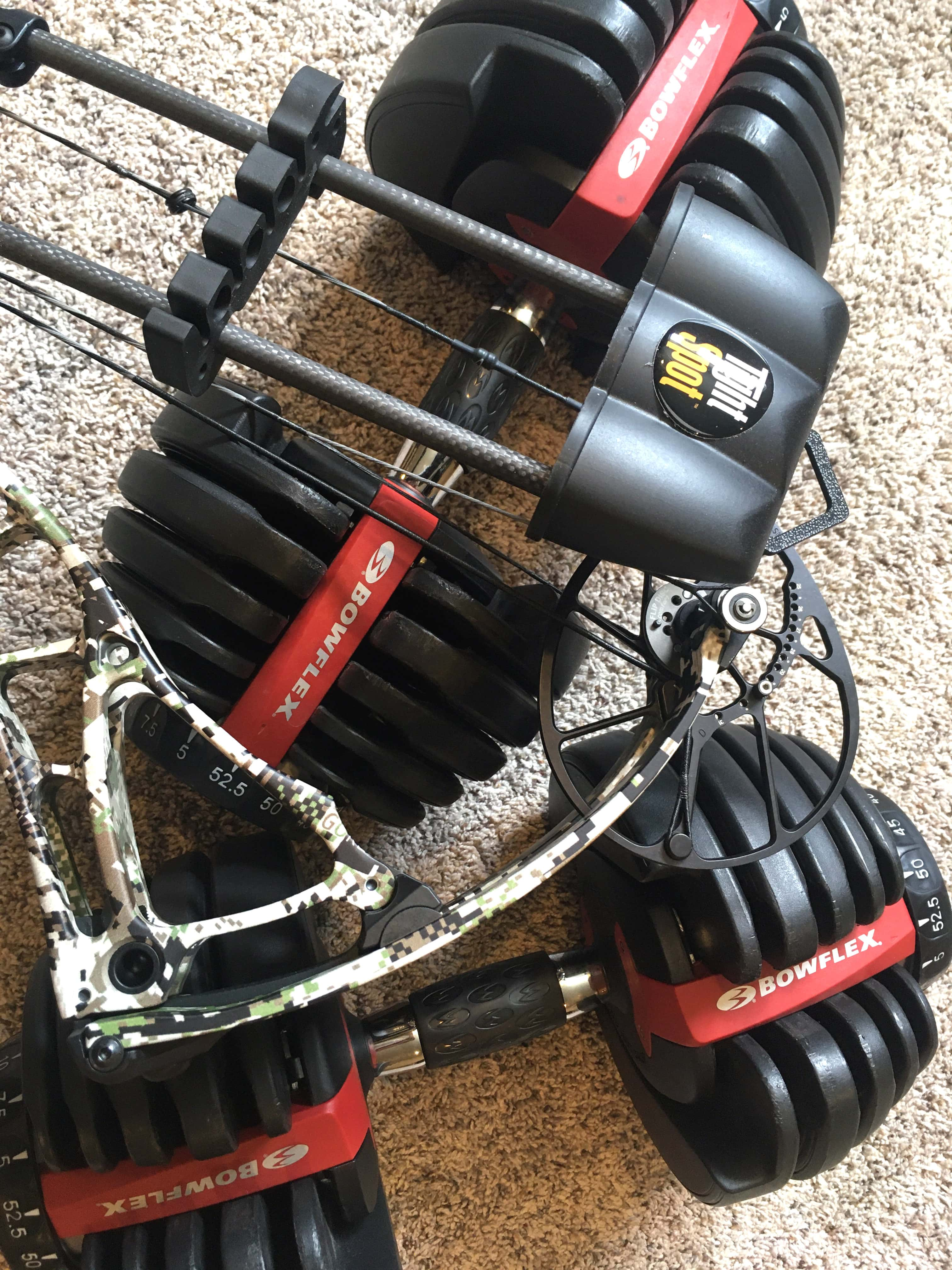
Mix up your fitness regimen, as pulling back on a bow string can provide similar resistance as using a dumbbell set. Add fun outdoor activities to the mix such as hiking, biking, running and walks with the dog, to keep things from getting boring and encourage consistency when getting ready for fall hunting seasons. Simonson Photo.
By Nick Simonson
The path to a successful hunt involves a lot of planning.
Whether it’s hours of country cruising and scouting the local deer herd and their movements in August and September for November’s glorious capstone to autumn or checking laces and boot leather and getting hundreds of rounds put in at the trap range to be set for that first flushing rooster in October, preparation for whatever game you pursue makes the season more successful. One thing many hunters overlook, however, is the physical preparation which helps make the hills seem less steep and the hauling out of a downed deer feel more like a victory lap and less of a chore.
By starting on the process of getting fit for a hunt now – whether you’re a weekend warrior who seeks out grouse or pheasants in the grassy expanse of the prairie, or will luck out and draw that coveted mule deer tag or a once-in-a-lifetime elk opportunity that will require some reconnaissance and efforts in the rugged breaks of the west – you’ll be more prepared to take on the challenges this fall. Additionally, the added health benefits and good habits that come with your pre-season physical challenges will help ensure you can keep going into the field season after season.
Goal Setting
For some hunters, the process of preparing for the field or changing their physical activity level may simply mean leaving the couch (or the comfort of that cushy air-ride-equipped boat seat) this summer. For those who are already active, it may mean upping your training regimen to prepare for those rugged hunts in the badlands, or the mountains a bit further the west, depending on your tag allotment for this autumn. For Sarah Newgard, Certified Personal Trainer and Owner-Operator of The Pedal cycling and fitness studio in Grand Forks, while goals should be a focus, it’s important to remember the reason behind them as well.
“I encourage people to write down their goals and then why they want to achieve that,” Newgard suggests as the first step to reaching fitness objectives for anyone, including hunters, “the why is so important,” she stresses, suggesting that a goal of losing 20 pounds is great, but putting the motivation behind it – such as being lighter and more in shape for the field – helps give it more meaning.
From there, it’s much like the hunt itself in terms of executing small steps toward the larger goal of tagging a deer or bagging a brace of birds on opening morning. Newgard cautions against running pell-mell at full speed toward a goal, however, especially if you’re just starting out. Taking things slow to start and gradually building the physical preparation process and workout intensity is key in preventing soreness, injury and burnout early on.
“People think that they have to work out seven days a week for sixty minutes at a time right out of the gate,” Newgard states in relation to those who are eager to get going on their fitness journey, instead suggesting, “maybe you start with one, two or three days a week, and just be consistent with that for one, two, three weeks before you start adding on; everybody thinks it needs to be this huge, gigantic goal, when really you can start small, and consistency is the key,” she concludes.
Make and Keep It Fun
One of the biggest challenges of developing a consistent fitness program may be overcoming the drudgery often associated with a set of dumbells or the repetitive whir of a treadmill or elliptical machine. Summer on the northern plains, however, provides an incredible opportunity to get outside and to mix things up and change the scenery. Being sneaky with your fitness activities is a recommendation of Lane Hanzel, Strength Conditioning Specialist at Sanford, Bismarck and avid big game hunter who has taken deer, elk and pronghorn in eight western states.
“Find things that you may not think of when building fitness – hiking, shed hunting, kayaking – and look at what you’re doing already that may be able to fall into building your own personal fitness routine,” he suggests, adding that being active in any outdoor pursuit that requires motion will help beat the monotony of regular workouts and become a habit and an enjoyable one at that.
It is that consistency of being active that will help preserve a level of fitness for future seasons and help prevent any need to start or re-start a regimen each summer to get set for the following fall. With those healthy habits built up and a variety of exercise options available – whether traditional weights and cardio at a local gym, or a run or mountain bike ride on a local trail – Hanzel suggests a lifetime of successful hunts and outings with less fatigue are more likely, even into a hunter’s later years.
“If they have that elk tag or that mule deer badlands tag they drew and they’re looking at ‘how I am going to get going’, the number one thing is, if you’re in shape already or you have something you’re doing, don’t get out of shape,” he advises, “don’t think of it as an eight-week program or a 12-week program, look at it as ‘this is what I do as part of my year-round program;” things may change or you might have different goals depending on the year,” he continues, suggesting developing a base and maintaining consistency is far better than trying to ramp up ahead of a hunting season.
With these ideas in mind, all sportsmen looking to get fit can adjust their preparation for an upcoming hunt in a manner that is both concrete in goals and execution against them.
Finding fun ways to mix it up and build endurance, strength and flexibility through traditional means and time preparing on the trail or in the field ahead of the hunt helps build a base and create a point to be ready for adventures this fall and in autumns to come.

